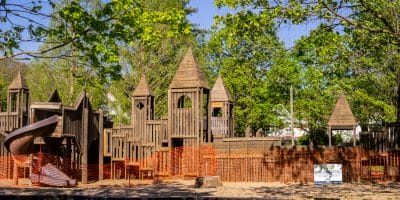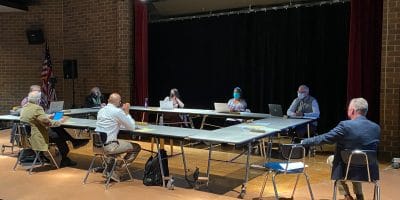
by Bridget Manley, publisher
One week into the new academic year, James Madison University has announced it will transition to online learning at the end of the week for at least the rest of September. In an email announcement sent to the university community Tuesday evening, the university asked all on-campus residents to return home by September 7.
The move comes as the JMU student newspaper, The Breeze, which has been tracking the number of cases through a university dashboard launched last week, reported more than 500 cases on campus as of Tuesday morning.
“We saw a very worrisome sharp uptick in positive COVID-19 cases in our student population,” said Caitlyn Read, the university spokesperson. “We also ran into some concerns about our ability to offer isolation and quarantine space, and those two factors coupled led us to take this action to immediately de-populate our campus.”
In the email, the university said that officials will monitor developments through September, leaving open the possibility of returning to in-person instruction on or after October 5.
“This was certainly a very difficult decision by the university, but the correct one in my opinion,” said Harrisonburg Vice-mayor Sal Romero, in an email to The Citizen. “The health and safety of our JMU students and faculty, as well the broader Harrisonburg community is paramount. I recognize this is going to have a significant impact at some many levels, but I remain optimistic we will overcome this together. It is my hope we can welcome JMU students back on campus soon!”
Some students criticize university’s approach
On campus, some students say the university has mismanaged what was an obvious crisis-in-the-making, and blame spiking case numbers on its failure to enforce protocols such as mask wearing, adequate space for social distancing in classrooms and capacity limits in dining halls.
The Twitter account @JMU411 has been posting updates on how those plans have turned out. Among the photos posted to the account are ones showing large groups of students congregating in dining halls and at outdoor events. Others show classrooms with every other seat taped off, potentially leaving far less than six feet of space between students.
Ryan Ritter, chair of the COVID-19 response committee for the Student Government Association, has been working with administrators for months to help craft the comprehensive reopening plan. Going into the semester, he said he felt confident that protocols were in place to protect everyone on campus. That quickly deteriorated, however, when he saw poor enforcement of mask mandates and social distancing protocols.
On Sunday, Ritter published a Twitter thread cataloguing the breakdown of promises made by JMU and the reality of life on campus.
“The dining halls, oh my gosh, they are very full,” Ritter said, in a phone interview. “You have lines going out the doors, no social distancing at all, you have students sitting at tables of ten with no masks on while they need to eat, and it’s just a complete mess. I was told that there would be some system of monitoring – at the dining halls, definitely, and then maybe at some other locations where it’s a grab and go system – that there would be a maximum capacity, but I have not seen that in place at all.”
Over the summer, Ritter said he was assured by the administration that if a student believed they may have been exposed to COVID or were awaiting test results, they would be offered the option to take classes online or other accommodations. Ritter says, however, that he has received reports that professors have told students “there would be no online option,” leaving potentially infected students to either attend classes while awaiting test results or miss class.

Read acknowledged the university’s struggles with online options were one reason the university decided to pivot.
“We’ve been in class now for only a few days, and we have observed an uptick in student absenteeism. That is one of the key considerations we were looking at,” Read said. “Understanding that uptick in student absenteeism and the challenges that creates for our professors to be teaching in dual modalities, right, that was a key driver in bringing the whole operation online.”
Ritter also said that many classrooms simply cannot meet social distancing requirements designated in the university protocol, and that chairs are only spaced about a foot apart.
JMU students were asked to sign a pledge to wear masks when not in their dorm rooms, but Ritter said he saw plenty of students not wearing masks and no enforcement when they were not.
“The administration has left a lot of the regulatory and policing power to students,” Ritter said. “I have personally witnessed groups of 30 people at a time doing activities on campus. No masks, physical activity, playing sports. I’ve seen people employed by the university walk by and not say a thing.”
Read noted that mask mandates and social distancing have been problematic across the country, and that the university has been working through ways to enforce masks on campus. She did acknowledge that the university had hoped that students would police themselves.
“We really hope that students enforce it themselves,” Read said. “That they will self-police and they will adhere to the rules and regulations, because the rules in these situations are really, really important.”
Read also addressed rumors that the university was waiting until the add/drop date to send students home. The deadline to drop classes with no penalty is September 15 – a later date than many universities, Read said.
She said that after that date, students who drop classes can apply for reimbursement, which will be considered case by case.
“If students are teetering back and forth on what to do, if they have questions about that, this is a very unique situation, and we will consider working with students on a one-on-one basis,” Read said. “If they want to go forward past the drop date but have a conversation with someone about pro-rated refunds we would be open to that.”
Read also says the university remains optimistic that students will be able to return in October, saying that they still appreciate in-person learning and the college experience.
“We had a very sober view of this going in, and knowing, unfortunately, that students would contract this disease. What happened was a confluence of many factors, not just an increase in case numbers, but also…the shortage of isolation and quarantine space. We started to get really concerned. This gives us the opportunity to step back, to address some of those concerns, and hopefully to have students back here in October.”
Journalism is changing, and that’s why The Citizen is here. We’re independent. We’re local. We pay our contributors, and the money you give goes directly to the reporting. No overhead. No printing costs. Just facts, stories and context. We’re also a proud member of the Virginia Press Association. Thanks for your support.
















